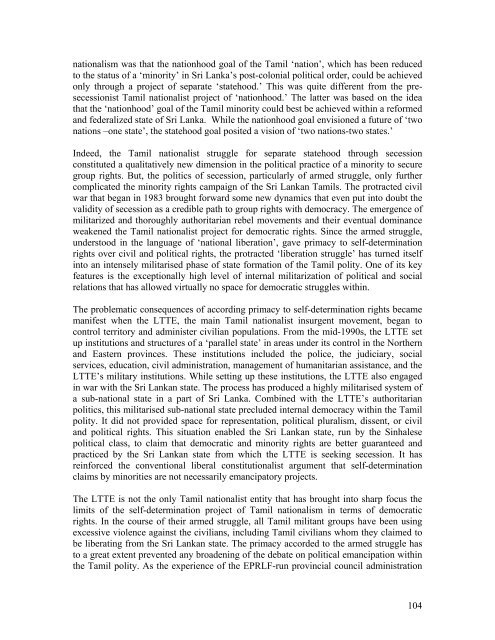Living on the Margins. Minorities in South Asia - EURAC
Living on the Margins. Minorities in South Asia - EURAC
Living on the Margins. Minorities in South Asia - EURAC
- TAGS
- minorities
- eurac
- www.eurac.edu
You also want an ePaper? Increase the reach of your titles
YUMPU automatically turns print PDFs into web optimized ePapers that Google loves.
nati<strong>on</strong>alism was that <strong>the</strong> nati<strong>on</strong>hood goal of <strong>the</strong> Tamil ‘nati<strong>on</strong>’, which has been reduced<br />
to <strong>the</strong> status of a ‘m<strong>in</strong>ority’ <strong>in</strong> Sri Lanka’s post-col<strong>on</strong>ial political order, could be achieved<br />
<strong>on</strong>ly through a project of separate ‘statehood.’ This was quite different from <strong>the</strong> presecessi<strong>on</strong>ist<br />
Tamil nati<strong>on</strong>alist project of ‘nati<strong>on</strong>hood.’ The latter was based <strong>on</strong> <strong>the</strong> idea<br />
that <strong>the</strong> ‘nati<strong>on</strong>hood’ goal of <strong>the</strong> Tamil m<strong>in</strong>ority could best be achieved with<strong>in</strong> a reformed<br />
and federalized state of Sri Lanka. While <strong>the</strong> nati<strong>on</strong>hood goal envisi<strong>on</strong>ed a future of ‘two<br />
nati<strong>on</strong>s –<strong>on</strong>e state’, <strong>the</strong> statehood goal posited a visi<strong>on</strong> of ‘two nati<strong>on</strong>s-two states.’<br />
Indeed, <strong>the</strong> Tamil nati<strong>on</strong>alist struggle for separate statehood through secessi<strong>on</strong><br />
c<strong>on</strong>stituted a qualitatively new dimensi<strong>on</strong> <strong>in</strong> <strong>the</strong> political practice of a m<strong>in</strong>ority to secure<br />
group rights. But, <strong>the</strong> politics of secessi<strong>on</strong>, particularly of armed struggle, <strong>on</strong>ly fur<strong>the</strong>r<br />
complicated <strong>the</strong> m<strong>in</strong>ority rights campaign of <strong>the</strong> Sri Lankan Tamils. The protracted civil<br />
war that began <strong>in</strong> 1983 brought forward some new dynamics that even put <strong>in</strong>to doubt <strong>the</strong><br />
validity of secessi<strong>on</strong> as a credible path to group rights with democracy. The emergence of<br />
militarized and thoroughly authoritarian rebel movements and <strong>the</strong>ir eventual dom<strong>in</strong>ance<br />
weakened <strong>the</strong> Tamil nati<strong>on</strong>alist project for democratic rights. S<strong>in</strong>ce <strong>the</strong> armed struggle,<br />
understood <strong>in</strong> <strong>the</strong> language of ‘nati<strong>on</strong>al liberati<strong>on</strong>’, gave primacy to self-determ<strong>in</strong>ati<strong>on</strong><br />
rights over civil and political rights, <strong>the</strong> protracted ‘liberati<strong>on</strong> struggle’ has turned itself<br />
<strong>in</strong>to an <strong>in</strong>tensely militarised phase of state formati<strong>on</strong> of <strong>the</strong> Tamil polity. One of its key<br />
features is <strong>the</strong> excepti<strong>on</strong>ally high level of <strong>in</strong>ternal militarizati<strong>on</strong> of political and social<br />
relati<strong>on</strong>s that has allowed virtually no space for democratic struggles with<strong>in</strong>.<br />
The problematic c<strong>on</strong>sequences of accord<strong>in</strong>g primacy to self-determ<strong>in</strong>ati<strong>on</strong> rights became<br />
manifest when <strong>the</strong> LTTE, <strong>the</strong> ma<strong>in</strong> Tamil nati<strong>on</strong>alist <strong>in</strong>surgent movement, began to<br />
c<strong>on</strong>trol territory and adm<strong>in</strong>ister civilian populati<strong>on</strong>s. From <strong>the</strong> mid-1990s, <strong>the</strong> LTTE set<br />
up <strong>in</strong>stituti<strong>on</strong>s and structures of a ‘parallel state’ <strong>in</strong> areas under its c<strong>on</strong>trol <strong>in</strong> <strong>the</strong> Nor<strong>the</strong>rn<br />
and Eastern prov<strong>in</strong>ces. These <strong>in</strong>stituti<strong>on</strong>s <strong>in</strong>cluded <strong>the</strong> police, <strong>the</strong> judiciary, social<br />
services, educati<strong>on</strong>, civil adm<strong>in</strong>istrati<strong>on</strong>, management of humanitarian assistance, and <strong>the</strong><br />
LTTE’s military <strong>in</strong>stituti<strong>on</strong>s. While sett<strong>in</strong>g up <strong>the</strong>se <strong>in</strong>stituti<strong>on</strong>s, <strong>the</strong> LTTE also engaged<br />
<strong>in</strong> war with <strong>the</strong> Sri Lankan state. The process has produced a highly militarised system of<br />
a sub-nati<strong>on</strong>al state <strong>in</strong> a part of Sri Lanka. Comb<strong>in</strong>ed with <strong>the</strong> LTTE’s authoritarian<br />
politics, this militarised sub-nati<strong>on</strong>al state precluded <strong>in</strong>ternal democracy with<strong>in</strong> <strong>the</strong> Tamil<br />
polity. It did not provided space for representati<strong>on</strong>, political pluralism, dissent, or civil<br />
and political rights. This situati<strong>on</strong> enabled <strong>the</strong> Sri Lankan state, run by <strong>the</strong> S<strong>in</strong>halese<br />
political class, to claim that democratic and m<strong>in</strong>ority rights are better guaranteed and<br />
practiced by <strong>the</strong> Sri Lankan state from which <strong>the</strong> LTTE is seek<strong>in</strong>g secessi<strong>on</strong>. It has<br />
re<strong>in</strong>forced <strong>the</strong> c<strong>on</strong>venti<strong>on</strong>al liberal c<strong>on</strong>stituti<strong>on</strong>alist argument that self-determ<strong>in</strong>ati<strong>on</strong><br />
claims by m<strong>in</strong>orities are not necessarily emancipatory projects.<br />
The LTTE is not <strong>the</strong> <strong>on</strong>ly Tamil nati<strong>on</strong>alist entity that has brought <strong>in</strong>to sharp focus <strong>the</strong><br />
limits of <strong>the</strong> self-determ<strong>in</strong>ati<strong>on</strong> project of Tamil nati<strong>on</strong>alism <strong>in</strong> terms of democratic<br />
rights. In <strong>the</strong> course of <strong>the</strong>ir armed struggle, all Tamil militant groups have been us<strong>in</strong>g<br />
excessive violence aga<strong>in</strong>st <strong>the</strong> civilians, <strong>in</strong>clud<strong>in</strong>g Tamil civilians whom <strong>the</strong>y claimed to<br />
be liberat<strong>in</strong>g from <strong>the</strong> Sri Lankan state. The primacy accorded to <strong>the</strong> armed struggle has<br />
to a great extent prevented any broaden<strong>in</strong>g of <strong>the</strong> debate <strong>on</strong> political emancipati<strong>on</strong> with<strong>in</strong><br />
<strong>the</strong> Tamil polity. As <strong>the</strong> experience of <strong>the</strong> EPRLF-run prov<strong>in</strong>cial council adm<strong>in</strong>istrati<strong>on</strong><br />
104

















